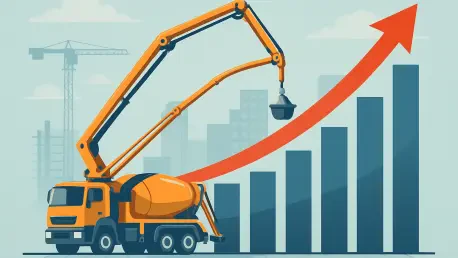The construction pump market stands as a cornerstone of the global construction machinery sector, poised for substantial growth as it meets the demands of a rapidly changing world. Valued at USD 5.7 billion in 2024, this market is forecasted to expand to USD 9.2 billion by 2034, achieving a steady compound annual growth rate (CAGR) of 4.9%. These pumps, essential for tasks such as dewatering, slurry handling, and concrete transportation, play a pivotal role in ensuring efficiency on building sites. As urban landscapes evolve and infrastructure projects multiply, the forces propelling this market forward come into sharp focus, revealing a complex interplay of demographic shifts, policy support, and technological progress. This growth trajectory underscores the importance of understanding the underlying drivers that are shaping the future of construction equipment.
Beyond mere numbers, the significance of construction pumps lies in their ability to address critical needs in an era of unprecedented urban expansion. With cities burgeoning and populations concentrating in metropolitan areas, the pressure to build resilient and modern infrastructure has never been greater. This dynamic environment sets the stage for an in-depth exploration of how urbanization, government initiatives, environmental challenges, and innovation are fueling the market’s ascent. The journey to 2034 promises to be one of adaptation and opportunity, as the industry responds to both economic and ecological demands with cutting-edge solutions and strategic regional focus.
Key Drivers of Market Expansion
Urbanization and Infrastructure Demand
The relentless pace of urbanization across the globe serves as a primary catalyst for the construction pump market’s robust growth. As millions migrate to urban centers, particularly in developing economies, the need for housing, transportation networks, and essential public utilities skyrockets. Construction pumps are indispensable in these scenarios, managing water and materials to keep projects on track. This surge in urban development is not merely a trend but a transformative force, reshaping skylines and necessitating equipment that can handle the scale and complexity of modern construction challenges. The Asia-Pacific region, for instance, exemplifies this shift, with sprawling cities emerging at an astonishing rate, driving consistent demand for reliable machinery to support foundational work.
Government-backed infrastructure initiatives further amplify this momentum, creating fertile ground for market expansion. Many nations are investing heavily in ambitious projects like smart cities and large-scale urban redevelopment, supported by policies aimed at modernizing public systems. These endeavors often involve significant funding and long-term planning, ensuring a steady pipeline of construction activity. Such efforts translate into a heightened need for efficient pumps capable of meeting the rigorous demands of mega-projects. This alignment of policy and market needs not only boosts confidence among manufacturers but also positions the industry to capitalize on opportunities in regions where infrastructure gaps are most pronounced, fostering sustained growth through the forecast period.
Disaster Management and Resilience
The increasing frequency and severity of natural disasters have emerged as a critical factor driving demand for construction pumps, particularly in regions vulnerable to climate-related events. Floods, hurricanes, and other extreme weather phenomena often leave construction sites and urban areas submerged, necessitating rapid dewatering solutions. Construction pumps are vital in these situations, enabling the swift removal of water to prevent delays and protect infrastructure. This role extends beyond mere convenience, positioning pumps as essential tools for community resilience in the face of environmental challenges. Areas prone to seasonal flooding or sudden disasters rely on this equipment to mitigate damage and maintain project timelines, highlighting a growing niche within the market.
Moreover, the emphasis on disaster recovery and preparedness adds a layer of urgency to the adoption of construction pumps. Governments and organizations in high-risk zones are increasingly prioritizing equipment that can support emergency response efforts, ensuring quick action during crises. This trend reflects a broader recognition of the need for infrastructure that can withstand and recover from natural calamities. Construction pumps, with their ability to handle large volumes of water and sludge, are becoming integral to such strategies, especially as climate patterns grow more unpredictable. The market’s response to this demand underscores its adaptability, catering to both planned development and unforeseen challenges, thereby solidifying its relevance in a world grappling with environmental uncertainties.
Technological and Industry Trends
Innovation in Pump Design
Technological advancements are revolutionizing the construction pump market, introducing solutions that enhance efficiency and align with global sustainability goals. The integration of Internet of Things (IoT) systems stands out as a game-changer, enabling real-time monitoring of pump performance. This capability allows contractors to detect issues before they escalate, minimizing downtime and optimizing project schedules. Additionally, IoT-enabled pumps provide valuable data on usage and maintenance needs, empowering companies to make informed decisions. This shift toward smart technology reflects a broader industry move toward digitization, where equipment is not just a tool but a connected asset contributing to overall project success, driving market competitiveness.
Energy efficiency is another pivotal focus in pump design, responding to both regulatory pressures and cost-conscious market demands. Modern pumps are engineered to consume less power while maintaining high performance, reducing operational expenses and environmental impact. This trend is particularly significant in developed markets where stringent standards for sustainability are in place, pushing manufacturers to innovate continually. However, the appeal of energy-efficient models extends to emerging economies as well, where budget constraints make low-cost operation a priority. By addressing these dual needs, advancements in pump technology are reshaping the competitive landscape, offering manufacturers a distinct edge as they cater to a diverse global clientele seeking greener, smarter solutions.
Market Preferences and Segmentation
Market preferences within the construction pump sector reveal a clear inclination toward specific types and capacities that balance performance with affordability. Centrifugal pumps, which accounted for USD 2.1 billion in revenue in 2024, dominate due to their versatility and cost-effectiveness. These pumps excel in handling water and viscous liquids, making them ideal for a wide range of construction tasks, from dewatering to sludge management. Their widespread adoption across both small and large projects highlights a preference for reliable, proven technology that delivers consistent results without straining budgets. This dominance signals a market that values practicality, favoring equipment that can adapt to varying site conditions while maintaining operational efficiency.
In parallel, pumps with capacities below 100 horsepower hold a commanding 55% market share, reflecting a strong demand for portable and lightweight solutions. These smaller pumps are particularly favored in small to mid-scale projects, where mobility and ease of use are critical. Their popularity is especially evident in emerging markets, where contractors often operate under tight financial constraints and prioritize equipment that offers flexibility without compromising functionality. This trend underscores a broader industry dynamic, where diverse project scales drive the need for a spectrum of equipment options. By catering to these varied requirements, the market demonstrates its ability to address niche demands, ensuring accessibility for contractors of all sizes and further fueling its growth trajectory.
Regional Growth Dynamics
High-Growth Regions
The Asia-Pacific and Middle East regions stand out as powerhouses of growth for the construction pump market, driven by rapid urbanization and ambitious infrastructure agendas. In Asia-Pacific, countries are witnessing an unprecedented influx of people into urban centers, necessitating extensive construction of housing, commercial spaces, and transportation networks. This demographic shift, coupled with government-led initiatives for smart cities, creates a robust demand for construction pumps to support foundational and ongoing projects. The scale of development in this region often involves complex, large-scale endeavors, where efficient water and material management are non-negotiable. As a result, manufacturers find fertile ground to expand their presence, capitalizing on the region’s pressing need for modern construction solutions.
Similarly, the Middle East is emerging as a critical hub for market expansion, fueled by visionary infrastructure projects and urban redevelopment plans. Nations in this region are investing heavily in creating futuristic urban landscapes, with initiatives that range from expansive transit systems to iconic architectural feats. Construction pumps play an integral role in these developments, ensuring that projects progress smoothly despite challenging environmental conditions such as arid climates. The region’s focus on diversification beyond traditional economic sectors further accelerates construction activity, positioning it as a key area for sustained demand. This regional momentum reflects a global shift, where emerging markets with significant infrastructure gaps drive the bulk of construction equipment needs, shaping market strategies through 2034.
Sustainability and Future Adaptation
The push for sustainability is profoundly influencing the construction pump market, particularly as environmental regulations tighten across various regions. In developed markets, there is a growing emphasis on reducing carbon footprints, prompting the adoption of energy-efficient pumps that lower power consumption without sacrificing performance. This trend is not just a response to policy but also a reflection of market demand for cost-effective operations over the long term. Manufacturers are thus compelled to innovate, developing pumps that meet stringent standards while maintaining competitive pricing. This focus on green technology is reshaping product offerings, ensuring that environmental responsibility becomes a core component of market growth strategies.
Looking ahead, the adaptation to smart technology and regional disparities will further define the market’s evolution. IoT integration and digital monitoring systems are expected to become standard features, enhancing the functionality of construction pumps in diverse settings. Meanwhile, the unique needs of high-growth regions like Asia-Pacific and the Middle East will continue to drive tailored solutions, addressing specific challenges such as water scarcity or rapid project timelines. This dual focus on innovation and localization ensures that the market remains agile, capable of meeting both universal sustainability goals and region-specific demands. As the industry progresses toward 2034, this adaptability will be crucial, cementing construction pumps as vital tools in a world of dynamic construction and environmental priorities.









